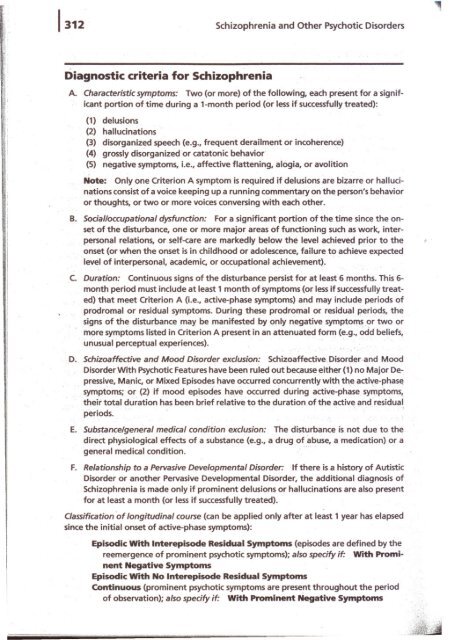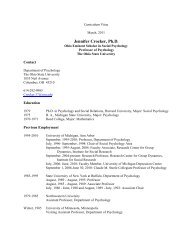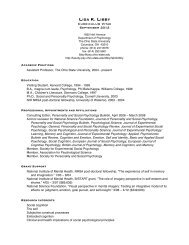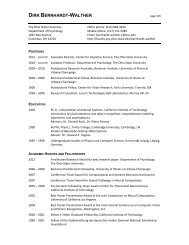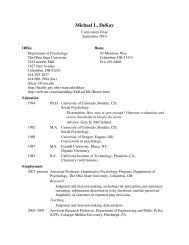Schizophrenia and Other Psychotic Disorders pg297-315.pdf
Schizophrenia and Other Psychotic Disorders pg297-315.pdf
Schizophrenia and Other Psychotic Disorders pg297-315.pdf
Create successful ePaper yourself
Turn your PDF publications into a flip-book with our unique Google optimized e-Paper software.
1:1<br />
II<br />
I<br />
Diagnostic criteria for <strong>Schizophrenia</strong><br />
<strong>Schizophrenia</strong> <strong>and</strong> <strong>Other</strong> <strong>Psychotic</strong> <strong>Disorders</strong><br />
A. Characteristic symptoms: Two (or more) of the following, each present for a significant<br />
portion of time during a 1-month period (or less if successfullytreated):<br />
(1) delusions<br />
(2) hallucinations<br />
(3) disorganized speech (e.g., frequent derailment or incoherence)<br />
(4) grossly disorganized or catatonic behavior<br />
(5) negative symptoms, i.e., affective flattening, alogia, or avolition<br />
Note: Only one Criterion A symptom is required if delusions are bizarre or hallucinations<br />
consist of a voice keeping up a running commentary on the person's behavior<br />
or thoughts, or two or more voices conversing with each other.<br />
B. Social/occupational dysfunction: For a significant portion of the time since the onset<br />
of the disturbance, one or more major areas of functioning such as work, interpersonal<br />
relations, or self-care are markedly below the level achieved prior to the<br />
onset (or when the onset is in childhood or adolescence, failure to achi~ve expected<br />
level of interpersonal, academic, or occupational achievement) ..<br />
C. Duration: Continuous signs of the disturbance persist for at least 6 months. This 6month<br />
period must include at least 1 month of symptoms (or less if successfullytreated)<br />
that meet Criterion A (Le., active-phase symptoms) <strong>and</strong> may include periods of<br />
prodromal or residual symptoms. During .these prodromal or residual periods, the<br />
signs of the disturbance may be manifested by only negative symptom~,or two or<br />
more symptoms listed in Criterion A present in an attenuated form (e.g., odd beliefs;<br />
unusual perceptual experiences).' . ,<br />
D. Schizoaffective <strong>and</strong> Mood Disorder exclusion: Schizoaffective.Disorder,<strong>and</strong> Mood<br />
Disorder With <strong>Psychotic</strong>Features have been ruled out because either (1) no Major Depressive,Manic,<br />
or Mixed Episodes have occurred cC?ncurrentlywith th~ acti\,e-phas~<br />
symptoms; or (2) if mood episodes have occurred during active-phase symptoms"<br />
their total duration has been brief relative to the duration of the active <strong>and</strong> residual<br />
~~, .<br />
E. Substance/general medical condition exclusion: The disturbance is not due to the<br />
direct physiological effects of a substance (e.g., a drug of abuse, a medication) or a<br />
general medical condition .... , ,<br />
F. Relationship to a Pervasive Developmental Disorder: Ifthere is a history of Autistic<br />
Disorder or another Pervasive Developmental Disorder, the additional diagnosis of<br />
<strong>Schizophrenia</strong> is made only if prominent delusions or hallucinations are also present<br />
for at least a month (or less if successfullytreated).<br />
Classification 'of longitudinal course (can be applied only after at least 1 year has elapsed<br />
since the initial onset of active-phase symptoms):<br />
Episodic With Interepisode Residual Symptoms (episodes are defined by the<br />
reemergence of prominent psychotic symptoms); also specify if: With Prominent<br />
Negative Symptoms<br />
Episodic With Nolnterepisode Residual Symptoms<br />
Continuous (prominent psychotic symptoms are present throughout the period<br />
of observation); also specify if: With Prominent Negative Symptoms


